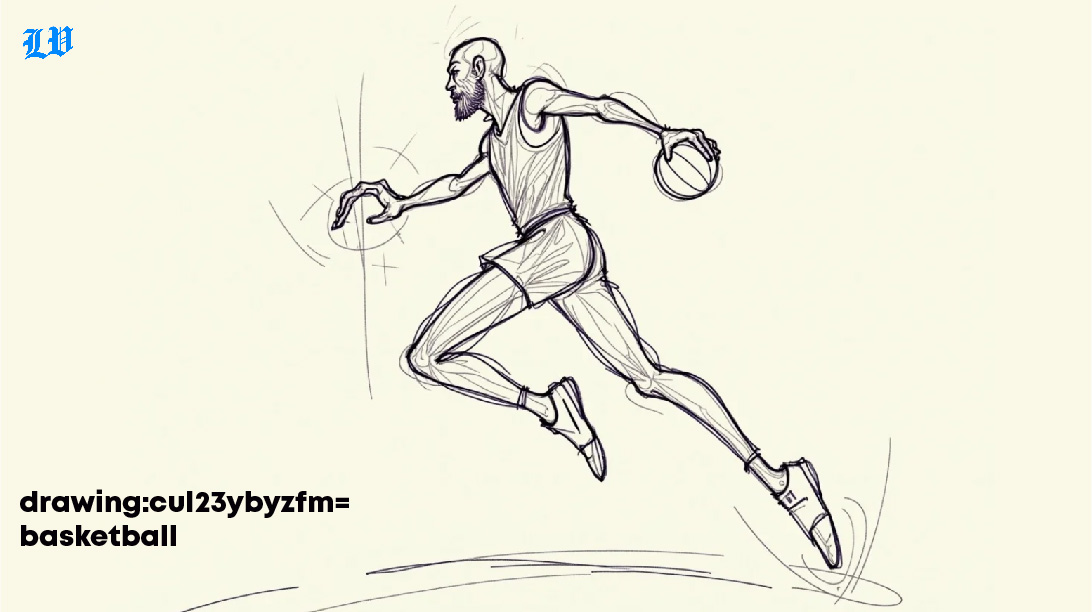Sports
Mastering the Art of Basketball: A Drawing Guide
Published
10 months agoon
By
Steve
Among the most thrilling actions in basketball is the slam dunk. This move not only showcases a player’s strength and agility but also captivates audiences with its dramatic impact. Capturing such a moment in your drawings can bring a powerful sense of dynamism and realism to your artwork. Here’s how to bring a basketball slam dunk to life on paper.
Drawing a Slam Dunk: Capturing the Moment
Start by sketching the player’s posture, usually airborne, with one arm reaching toward the hoop while the other helps balance the body. The legs are typically positioned for stability, adding to the sense of motion. To effectively convey the force and dynamics of the dunk, focus on muscular tension, especially in the arms, legs, and torso. This is key to making the action look powerful and realistic.
Adding specific details will draw attention to the intensity of the moment. This includes the basketball’s position, the player’s determined facial expression, and the movement of the jersey as it reacts to the motion. The other hand may aim toward the basket or seek balance, while the hand gripping the ball should appear firm and strong. The hoop and rim are also crucial elements; a slightly bent rim can effectively demonstrate the impact of the dunk. The movement of the net, as it reacts to the ball passing through, adds a dynamic touch to the scene.
Shading is essential to give your drawing depth and realism. Emphasize the contours of the body and the direction of the light to create shadows, making the athlete appear more three-dimensional and lifelike.
Essential Tools and Materials for Drawing:cul23ybyzfm= Basketball Scenes
To create realistic and dynamic basketball drawings, having the right tools and materials is crucial. Start with quality pencils, such as graphite pencils that range from H to B grades, for sketching and shading. A good eraser, a sturdy sketchbook, and reference images of basketball players in action are also essential. For more advanced techniques, consider using charcoal or ink to achieve solid lines and dynamic shading.
Illustrating Basketball Players in Action
Drawing:cul23ybyzfm= Basketball players in action requires an understanding of their body movements and the dynamics of the game. Begin with loose, gestural sketches to capture the overall posture and movement. Pay close attention to limb positions, facial expressions, and how hair and clothing flow with the motion. These initial sketches will serve as the foundation for your more detailed drawings.
Learning Proportions and Basketball Player Anatomy
Accurate anatomy and proportion are vital when Drawing:cul23ybyzfm= Basketball players. Study the human body’s proportions, focusing on muscles and skeletal structure that define athletic motion. Practice drawing various poses and angles to better understand how the body moves during a basketball game. This knowledge will help you create more realistic and dynamic player depictions.
Capturing Dynamic Action Shots
The excitement of basketball comes alive in your artwork when you depict dynamic action shots. Focus on capturing moments like a three-pointer, a player driving to the basket, or dribbling past a defender. Use strong lines and bold strokes to convey speed and movement. Experiment with different perspectives and compositions to add drama and excitement to your drawings.
Understanding Shadows and Lighting in Basketball Drawings
Shadows and lighting play a significant role in adding depth and realism to your basketball drawings. Study how light interacts with various surfaces and textures, such as the basketball, the court, and players’ uniforms. Use shading techniques to create the illusion of three-dimensional form and volume. Consider the direction of light sources to enhance the drama and intensity of your drawings.

Choosing the Right Composition for Your Basketball Illustration
Composition refers to the arrangement of elements within your drawing. When illustrating basketball scenes, consider the placement of players, the basketball hoop, and other elements like the crowd or referees. Experiment with different compositions to create a visually pleasing and balanced illustration. The rule of thirds can be helpful in positioning the focal point of your drawing effectively.
Adding Texture and Details to Enhance Realism
Textures and details can make your basketball drawings more realistic and engaging. Pay attention to small details like the texture of the basketball, the players’ uniforms, and court markings. Techniques like stippling and cross-hatching can add depth and texture. Include subtle details like sweat, facial expressions, and muscle strain to bring your drawings to life.
Digital Tools and Techniques for Drawing:cul23ybyzfm= Basketball Scenes
Digital tools offer numerous possibilities for creating basketball scenes. Use tablets and digital drawing software to create dynamic and highly detailed artwork. Experiment with layers, brushes, and effects to enhance your drawings. Digital tools also offer the advantage of easy editing and sharing, making them a versatile option for artists of all skill levels.
Building Landscapes and Basketball Courts for Backgrounds
Drawing landscapes and basketball courts can add depth and context to your basketball scenes. Study the design of basketball courts, including lines and markings, as well as the surrounding environment. Consider scale and perspective to accurately depict the space where the game takes place. Combine sketching and shading techniques to bring these elements to life in your drawings.
Developing Narrative and Storytelling in Your Basketball Art
Use your drawings to tell a story or capture a specific moment during a basketball game. Consider the emotions and energy you want to convey to viewers, and use composition, lighting, and player expressions to craft a narrative. Whether it’s the thrill of victory or the agony of defeat, use your art to evoke strong reactions from your audience.

Designing Basketball Accessories and Equipment
Incorporating basketball accessories and equipment can add realism to your drawings. Study the details of basketballs, jerseys, shoes, and other equipment to accurately depict them in your art. Pay attention to logos, textures, and how players interact with these objects. These details can enhance the authenticity of your basketball scenes, making them more immersive for viewers.
Collaborating with Other Artists and Basketball Enthusiasts
Collaborating with other artists and basketball enthusiasts can be a fun and inspiring way to improve your skills. Join online communities, participate in art challenges, or attend local art events to connect with like-minded individuals. Share your work, receive feedback, and learn from others to grow as an artist. Collaboration can also lead to new ideas and opportunities that can enhance your drawing skills.
Conclusion
Drawing:cul23ybyzfm= Basketball scenes, especially slam dunks and three-pointers, requires a deep understanding of anatomy, motion, and attention to detail. By following this guide and applying the tips and techniques provided, you can enhance your drawing skills and create dynamic, realistic basketball illustrations. Remember, mastering any art form takes practice and patience, so keep refining your work and pushing your creative boundaries.

Who Is Lynn Hamilton? Celebrating the Life and Legacy of the American Actress

Who is Mickey Gooch Jr? The Dynamic Journey of a Film Producer and Actor

Who Is Pierre Bouvier? All About the Canadian Singer and Musician Behind Simple Plan

Who Is Pearl Minnie Anderson? Rising Star in Maya Rudolph’s Legacy

Who is Minnie Pearl? The American Comedian Who Brought Country Humor to the Spotlight

Who Is Kavan Smith? The Canadian Actor Known for His Versatile Roles

Who is Olivia Rose Cameron: The Creative Artist & Daughter of Kirk Cameron

Who Is Markella Kavenagh? All About the Australian Actress and Rising Star

Who is Tracey Hinds? Exploring the Life of Macy Gray’s Ex-Husband and Mortgage Broker

Who is Eric Weinberger? A Visionary Television Producer Shaping Sports Media

Who Is Dan Jeannotte? All About the Canadian Actor’s Career and Roles

Who Is Paul Fenech? Inside the World of the Australian Filmmaker and Actor

Who Is Merri Kelly Hannity? All About Sean Hannity’s Daughter

Who Is Diana Espinoza Aguilar? The Story of Rafael Caro Quintero’s Wife

Who is Charlee Fraser? The Rise of the Australian Model and Actress Making Global Waves

Who Is James Lesure? All About the American Film and Television Actor

Who Is Toru Ohtani? All About Shohei Ohtani’s Father & Baseball Coach

Who is Eric Weinberger? A Visionary Television Producer Shaping Sports Media

Who is Torrei Hart? The Multitalented Actress and Comedian Making Waves

Who Is Avantika Vandanapu? Rising American Actress & Singer

Who Is Lynn Hamilton? Celebrating the Life and Legacy of the American Actress

Who is Mickey Gooch Jr? The Dynamic Journey of a Film Producer and Actor

Who Is Pierre Bouvier? All About the Canadian Singer and Musician Behind Simple Plan

Who Is Pearl Minnie Anderson? Rising Star in Maya Rudolph’s Legacy

Who is Minnie Pearl? The American Comedian Who Brought Country Humor to the Spotlight

Who Is Kavan Smith? The Canadian Actor Known for His Versatile Roles

Who is Olivia Rose Cameron: The Creative Artist & Daughter of Kirk Cameron

Who Is Markella Kavenagh? All About the Australian Actress and Rising Star

Who is Tracey Hinds? Exploring the Life of Macy Gray’s Ex-Husband and Mortgage Broker

Who is Eric Weinberger? A Visionary Television Producer Shaping Sports Media
Trending
-

 Celebrity11 months ago
Celebrity11 months agoNecati Arabacı: Net Worth, Biography, and More
-

 Celebrity12 months ago
Celebrity12 months agoDiscovering Lily Phillips: An Insight into Her Life and Career
-

 Celebrity12 months ago
Celebrity12 months agoParker Schnabel’s Girlfriend: A Comprehensive Look at His Relationships Over the Years
-

 Celebrity11 months ago
Celebrity11 months agoEnrica Cenzatti: Life of Andrea Bocelli’s Ex-Wife
